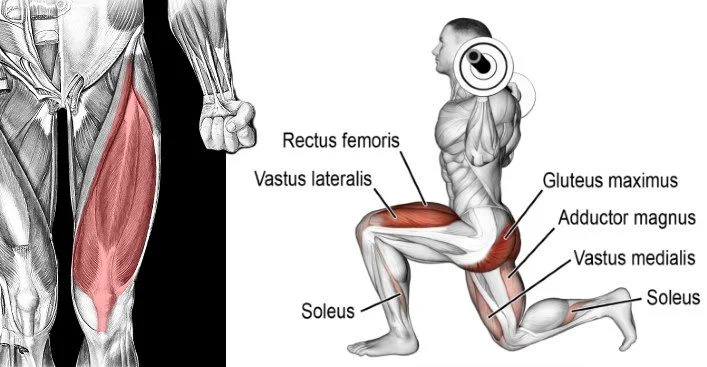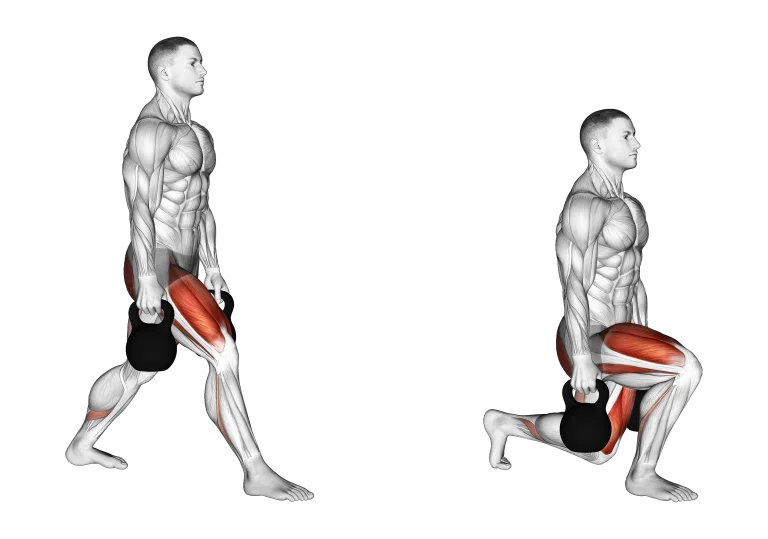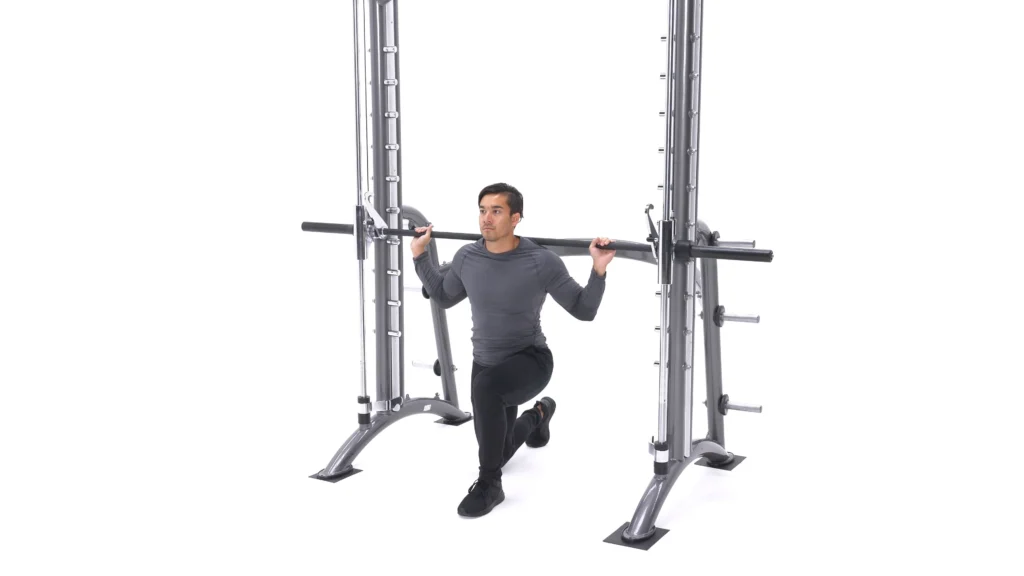Walking lunges are a great exercise for strengthening and toning your lower body, including your quadriceps, hamstrings, glutes, and core. They are also a great way to burn calories and improve your cardiovascular health.
Interval training is a type of workout that involves alternating between periods of high-intensity exercise and rest. This type of training is very effective for burning calories and improving your fitness level.
What are walking lunges?
The walking lunge is a single-leg exercise that belongs to the lunge family. It is a powerful technique that can raise your heart rate like cardio, build muscle strength and tone, enhance balance, and promote lower body mobility.
Moreover, unlike other lunge variations that require you to remain stationary, step back to the starting position, or do a forward and backward lunge without moving, the walking lunge allows you to progress ahead and walk directly through to the next lunge.
walking lunges benefits
- Quadriceps: This muscle group consists of four muscles located on the front (front) thigh: the rectus femoris, vastus lateralis, vastus intermedius, and vastus medialis. These muscles, which extend the knee and flex the hip, are vital for walking and sprinting. They work as synergists on the way down and as main movers on the way up during lunge walking. (1)
- Gluteal Muscles: The gluteus maximus is the largest butt muscle, and it is responsible for straightening the leg at the hip. The gluteus medius is a lesser muscle that lies beneath the gluteus maximus. It functions during external and internal hip rotation, as well as hip abduction. The glute minimus is the smallest of the glutes and performs the same activities as the glute medius. During the eccentric portion of the lunge, the gluteus medius and minimus stabilize the hip, whereas the gluteus maximus straightens the hip during the ascent phase. (2)
- Calves: The gastrocnemius, soleus, and tibialis anterior muscles comprise the calves. The gastrocnemius is a muscle with two heads that goes from the knee to the heel. It operates by flexing the leg at the knee joint and plantar flexing the ankle joint. It also helps with plantar flexion, especially when the knee is bent. Its counterpart, the soleus, is so similar that some people refer to it as one muscle. The tibialis anterior is found in front of the tibia. It runs from the knee to the foot and is responsible for the dorsiflexion of the ankle. The gastrocnemius assists the tibialis during the eccentric portion of the lunge. During the concentric section, the load is carried by the gastrocnemius and soleus. (3)
- Hamstrings: This involves three muscles on the back of the thigh. The semimembranosus, semitendinosus, and biceps femoris muscles work together to extend and flex the hip and knee. They typically function as a synergist with the quadriceps during the lowering part of the lunge.
- Hip Flexors: The iliac and psoas major are hip flexor muscles. They collaborate to bend the hip and lift the femur bone toward the pelvis, which helps to stabilize the hip. Because these muscles are frequently shortened and cause back pain from prolonged sitting, hip flexor workouts are essential. During the eccentric portion of the lunge, the iliacus acts as a synergist with the psoas. Lunges are quite effective at both stretching and strengthening these muscles.
walking lunges muscles worked

Primary muscles worked:
- Quads
- Glutes
- Adductors
Secondary muscles worked:
- calves
- abdominals (4)
- hips (5)
walking lunges with dumbbells form
How to do Dumbbell Walking Lunge correctly
Instructions
- Set up yourself with your feet shoulder-width apart and a dumbbell in each hand.
- Step forward with one leg, allowing both knees to bend at the same time.
- Descend till your back knee is on the floor.
- As you get up fully and return to the starting position, drive through the front foot and extend the knee.
- Rep with the opposite leg.
- Repeat the desired number of repetitions.
Tips
- Do not continue to the raised form of this activity until you have fully mastered the bodyweight version. Increasing the range of motion without the necessary motor control is a formula for disaster. Learn to walk before attempting to run.
- Walking lunges are a more complex progression that should be used only once you have achieved the necessary hip and core stability. A proper single-leg progression plan would look something like this:
- Step Up
- Split Squat > Front foot elevated
- Reverse Lunge > Front foot elevated
- Single Leg Squat to Bench
- Lateral Lunge
- Bulgarian/Rear Foot Elevated Split Squat (RFESS)
- Single Leg Squat From Bench
- Walking Lunge
- Forward Lunge
- Single-leg skater Squat
- Pistol Squat
- Don’t rush through the progression plan; earn the right to use each exercise and don’t skip any of them.
- When you go to push back to the starting position, fight the urge to lead the movement with your shoulders by hyperextending at your spine. Instead, look to drive the movement via force from your lower body.
- At the bottom of the movement, both of your legs should be at 90-degree angles at the knees.
- Remember that if you want to stress the quads in any lunge or split squat pattern, take a little smaller stride and drive up through the ball of the foot.
- Focus on taking a slightly larger step and driving up through the heel of the foot if you want to engage the glutes and hamstrings during any type of lunge or split squat routine.
Common mistakes to avoid
Lunging on a tightrope
Avoid stepping into the lunge with your feet too close together. Instead of putting one foot in front of the other, try lunging like you’re on train lines that are hip-width apart. (6)
This will assist you in keeping your feet in the proper line and maintaining your balance.
Not going low enough
Cutting the lunge short and not going all the way down is not just a bad idea, but it also eliminates some of the lunge’s particular benefits. When you get into the exercise, your muscles must stretch and strengthen across the complete range of motion in order to force muscle growth. (7)
Stepping too far or too short
If you take too long a step, you may injure your groin or hip flexors. If you take too short a step, you will struggle to keep your balance and may have knee pain.
Aim for about 2 feet. Check that both knees are at 90-degree angles at the bottom of the action.
Leaning forward
Because the walking lunge forces you to continue going right into the next lunge, your upper body may begin to lean forward to assist you in shifting as you lunge. This is a regular occurrence when working too quickly to finish a set.
This can result in lower back pain since your core is not engaging as it should. Check that your abs are engaged and that your upper body is perpendicular to the floor.
Lifting the front heel
Lifting your front heel as you bend your knee is another sign of moving too rapidly through the exercise, which can put unneeded strain on your knee. On each exercise, keep your entire foot down and drive into the heel.
If your foot or ankle lacks the necessary mobility, you may want to investigate these lunge alternatives until they improve sufficiently to execute the walking lunge.
Caving the knees in
If you feel your knee cave in during the lunge, this is most likely a result of moving too quickly and having a weak mind-muscle connection. Maintain a straight line between your ankle, knee, and hip, and make sure your knee is not collapsing in or out.
Safety Tips
Walking lunges are more difficult to balance and coordinate than static lunges. One of the most serious concerns is harming oneself due to a lack of equilibrium. Incorrect form can also raise your chances of tearing a muscle.
Follow these tips to stay safe:
- Keep your body upright through the movement. Try to avoid leaning forward too much.
- Keep your core engaged throughout the entire lunge.
- Don’t overextend your leg when you lunge forward, which can cause your back to arch.
- Try to step out enough so your body is comfortable vertically, and your torso and hips are straight down. Not stepping out far enough is also unsafe for your knees and can lead to injuries.
If you’re new to exercising, working with a trainer or a friend or family member who is familiar with walking lunges can be beneficial. They can check your form and give you ideas on how to get the most out of this motion.
walking lunges workout intervals
The optimal walking lunge intervals are determined by your fitness level and goals. If you are new to exercising, you should begin with shorter intervals or fewer repetitions. As you gain strength, you can increase the length of the intervals or the number of repetitions.
Here are some recommended interval schemes for 3, 5, and 7 minutes of walking lunges:
3 minutes:
- 30 seconds of walking lunges
- 30 seconds of rest
- Repeat 3 times
5 minutes:
- 45 seconds of walking lunges
- 30 seconds of rest
- Repeat 5 times
7 minutes:
- 1 minute of walking lunges
- 30 seconds of rest
- Repeat 7 times
The interval pattern can be tailored to your fitness level and goals. If you are new to exercise, for example, you can begin with 20 seconds of walking lunges and 40 seconds of rest. As you gain strength, you can extend the walking lunge time to 30 seconds and the rest period to 30 seconds.
walking lunges Alternatives
Split Squats

Split squats are a more static alternative to the lunge since they have a virtually comparable stance and muscle recruitment pattern but do not involve lifting the feet off the floor.
The split squat is an excellent choice for lifters who want to maximize volume or weight lifted while undergoing a less functional training stimulus.
Step-Ups

Step-ups can be substituted for lunges to increase the dynamic quality of the movement.
Step-ups, as the name suggests, entail the lifter stepping up and off an elevated platform, mimicking the overall muscle recruitment and movement pattern of lunges but at a higher intensity.
Step-ups are perfect for athletes, people looking to boost their caloric expenditure, or those simply looking to reap the benefits of dynamic exercise.
Smith Machine Lunges

The Smith machine lunge, while somewhat contentious because of the predetermined bar path and drawbacks inherent in the Smith machine, serves rather well as a heavier alternative to the normal lunge.
The Smith machine lunge, with its higher loading capacity, self-stabilizing resistance, and a few additional safety features, can be highly useful as a supplementary lower body exercise – or for people who have difficulty maxing out with free weight lunges.
walking lunges with a barbell

Walking lunges with a barbell is a compound exercise that targets many lower-body muscular groups, including your quadriceps, hamstrings, glutes, and core. They are also an excellent strategy to lose weight and improve your cardiovascular health.
walking lunges vs. Bulgarian split squats
Walking lunges are a dynamic exercise in which you must move forward while doing lunges. As a result, they are an excellent exercise for strengthening your balance and coordination. Walking lunges also develop your core muscles because you must activate your core to maintain balance.
Bulgarian split squats are a static exercise in which you balance on one leg while squatting with the other. As a result, they are an excellent workout for developing your quads, hamstrings, and glutes. Bulgarian split squats also stimulate your core muscles because you need to activate your core to stay balanced.
| Characteristic | Walking lunges | Bulgarian split squats |
|---|---|---|
| Type of exercise | Dynamic | Static |
| Primary muscle groups targeted | Quadriceps, hamstrings, glutes, core | Quadriceps, hamstrings, glutes, core |
| Balance and coordination | Yes | Yes |
| Core engagement | Yes | Yes |
| Equipment needed | None or barbell | None or dumbbell/kettlebell |
| Difficulty level | Beginner to intermediate | Intermediate to advanced |
FAQs
why are walking lunges so hard?
are walking lunges better than squats?
Are Walking Lunges and Lunges Different?
References
- Siregar, Y. I., & Nurkadri, N. (2023). Contribution of squat jump, leg squat, and walking lunge to mawashi geri kicking ability skills. Jurnal SPORTIF: Jurnal Penelitian Pembelajaran, 9(2), 355-368.
- Bushman, B. A., & Robinett, A. (2022). Neuromotor exercise training: background and benefits. ACSM’s Health & Fitness Journal, 26(4), 5-9.
- Bonder, I. J., & Shim, A. L. (2022). In-season training model for National Association of Intercollegiate Athletics female basketball players using “Microdosed” programming. Strength & Conditioning Journal, 10-1519.
- Kjeldsen, T., Reimer, L. U., Drejer, S. M., Hvid, L. G., Mecklenburg, I., & Dalgas, U. (2022). Is progressive resistance training feasible in patients with symptomatic external snapping hip? Physiotherapy Theory and Practice, 38(5), 704-716.
- Song, J. K., & Yoo, W. G. (2021). Effect of backward versus forward lunge exercises on trunk muscle activities in healthy participants. Physical Therapy Korea, 28(4), 273-279.
- Maniar, N., Cole, M. H., Bryant, A. L., & Opar, D. A. (2022). Muscle force contributions to anterior cruciate ligament loading. Sports Medicine, 52(8), 1737-1750.
- Hanish, S., Muhammed, M., Kelly, S., & DeFroda, S. (2023). Postoperative Rehabilitation for Arthroscopic Management of Femoroacetabular Impingement Syndrome: a Contemporary Review. Current Reviews in Musculoskeletal Medicine, 1-11.





